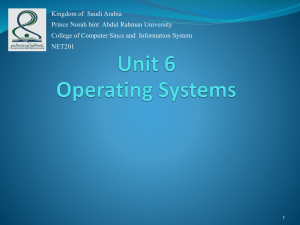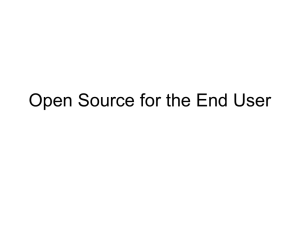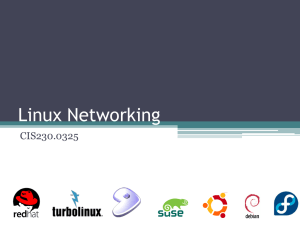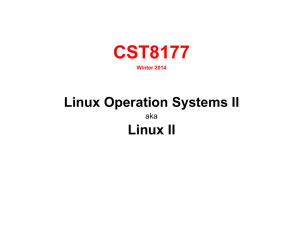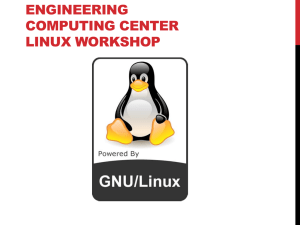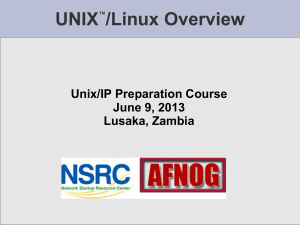Chapter 1
advertisement
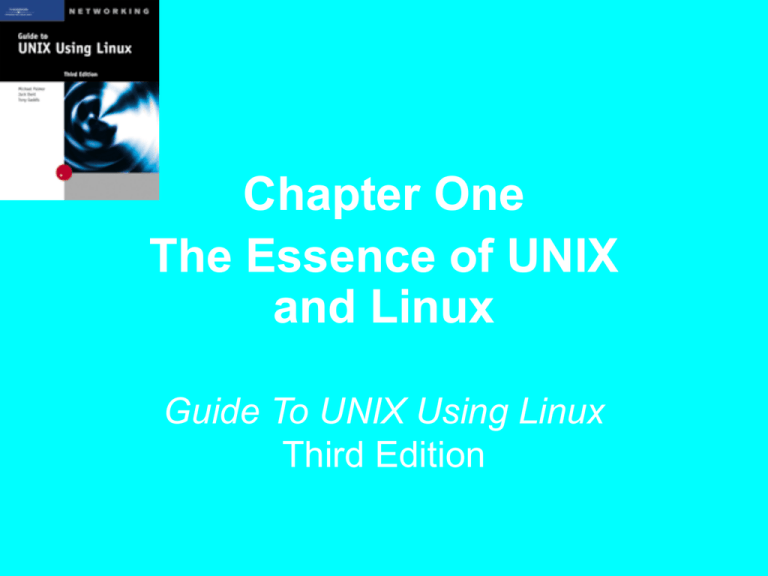
Chapter One The Essence of UNIX and Linux Guide To UNIX Using Linux Third Edition Objectives • Explain operating systems, including PC, mainframe, and network operating systems • Describe the UNIX and Linux operating systems • Explain the purpose of UNIX/Linux shells • Understand how to select user names and passwords • Connect to UNIX/Linux using Telnet or SSH Guide to UNIX Using Linux, Third Edition 2 Objectives (continued) • Use basic UNIX/Linux commands and commandline editing features • Explain the role of a system administrator • Change your password for security • Use multiple commands to view the contents of files • Redirect output to a file Guide to UNIX Using Linux, Third Edition 3 Understanding Operating Systems • Operating System (OS) – The most fundamental computer program – Enables you to store information, process raw data, use application software, compile your own programs, and access attached hardware, such as a printer or keyboard Guide to UNIX Using Linux, Third Edition 4 Understanding Operating Systems Guide to UNIX Using Linux, Third Edition 5 PC Operating Systems • A personal computer (PC) OS conducts all I/O, processing, and storage operations on a stand-alone computer Guide to UNIX Using Linux, Third Edition 6 Mainframe Operating Systems • A mainframe OS controls a large computer system with multiple processors for I/O, processing, and storage operations for many users Guide to UNIX Using Linux, Third Edition 7 Network Operating Systems • A network OS controls the operations of a server computer (host), which accepts requests from user programs running on other computers (clients) Guide to UNIX Using Linux, Third Edition 8 Server-based vs. peer-to-peer networks • Server-based network – Centralized processing approach – Data and applications server resident – If server fails, entire network fails • Peer-to-peer – Distributed processing approach – Data and applications workstation resident – Each system is both a server and a client Guide to UNIX Using Linux, Third Edition 9 Introducing the UNIX and Linux Operating Systems • UNIX/Linux can be used on systems functioning as: – Dedicated servers or client workstations in a server-based network – Client/server workstations connected to a peer-topeer network – Stand-alone workstations not connected to a network Guide to UNIX Using Linux, Third Edition 10 Introducing the UNIX and Linux Operating Systems (continued) • UNIX/Linux is a multi-user system • UNIX/Linux is a multitasking system – Can execute more than one program at a time • UNIX/Linux is a portable operating system – Used in many computing environments Guide to UNIX Using Linux, Third Edition 11 A Brief History of UNIX • Bell Labs originally developed UNIX in the late 1960s and early 1970s • Distributed in source code form • Universities modified the code to work on different machines • Two standard versions of UNIX evolved – System V (Bell Labs) – Berkeley Software Distribution (BSD) Guide to UNIX Using Linux, Third Edition 12 UNIX Concepts • Shell – The interface between user and OS • Hierarchical Structure – Directory and subdirectory organization • Layered components – Layers of software surround the computer’s inner core Guide to UNIX Using Linux, Third Edition 13 Guide to UNIX Using Linux, Third Edition 14 Linux and UNIX • Linux is UNIX-like – Not written from traditional UNIX code • Linux is original code – Includes POSIX standards • Other Linux information – Created by Linus Torvalds – Offers all the complexity of UNIX – Linux can coexist with other OSs Guide to UNIX Using Linux, Third Edition 15 Introducing UNIX/Linux Shells A shell is a UNIX/Linux program that interprets the commands you enter from the keyboard Guide to UNIX Using Linux, Third Edition 16 Choosing Your Shell • Shells interpret commands and act as first-class programming languages • A default shell is associated with your account when created; Bash is the default shell in Linux • Some UNIX/Linux shells: Bourne, Korn, C shell, Bash • Can switch from shell to shell Guide to UNIX Using Linux, Third Edition 17 Choosing User Names and Passwords • To use UNIX/Linux, a user must log in by providing a unique user name and password • UNIX/Linux system administrators create accounts by adding user names and passwords • Users log in to UNIX or Linux systems as long as they have accounts on the workstation or host (server) computer Guide to UNIX Using Linux, Third Edition 18 Connecting to UNIX/Linux Using Telnet or SSH • • • • • Remotely through Telnet Through network client software As peer on peer-to-peer network On a stand-alone PC Through a dumb terminal Guide to UNIX Using Linux, Third Edition 19 Connecting to UNIX Using Telnet • Telnet is terminal emulation software – Connects your PC to a server, or host • PC could be running UNIX, Linux, Windows OS, or Macintosh OS • Once connected to a UNIX/Linux host, work with UNIX/Linux may begin – Uses IP addresses or domain names to access remote systems Guide to UNIX Using Linux, Third Edition 20 Secure Shell (SSH) • Developed for UNIX/Linux systems to provide authentication security for TCP/IP applications, such as FTP and Telnet • Can encrypt communications as they go across a network or the Internet • openSSH includes protocols and software for free distribution on UNIX/Linux systems Guide to UNIX Using Linux, Third Edition 21 Logging In to UNIX/Linux • Log in by entering username and password when UNIX/Linux system booted or connected to • Enter at prompt (command-line mode) or into login box (GUI mode) • Now commands can be issued at the command prompt Guide to UNIX Using Linux, Third Edition 22 Logging In to UNIX/Linux (continued) With a standalone computer and an X Window desktop such as GNOME, you must open a terminal window to access the command prompt Guide to UNIX Using Linux, Third Edition 23 Using Commands • To interact with UNIX/Linux, a command is entered at the command prompt • UNIX/Linux is case-sensitive and most commands are typed in lower case • Two categories of commands – User-level: perform tasks – System administration: system management Guide to UNIX Using Linux, Third Edition 24 Using Commands (continued) • The date command – Displays the system date, which the system administrator maintains • The cal command – Shows the system calendar Guide to UNIX Using Linux, Third Edition 25 Using Commands (continued) Guide to UNIX Using Linux, Third Edition 26 Using Commands (continued) Guide to UNIX Using Linux, Third Edition 27 Using Commands (continued) • The who Command – To get information about who is logged in – Useful for administrators and users • The clear Command – Clears the screen • The whatis command – Displays a brief description of a command for help purposes Guide to UNIX Using Linux, Third Edition 28 Using Commands (continued) The man program displays the UNIX/Linux online reference manual, called the man pages, for help purposes Guide to UNIX Using Linux, Third Edition 29 Using Commands (continued) • Command-line editing – Certain keystrokes perform command-line editing (shell dependent) • Multiple command entries – More than one command on one line by separating with a semicolon(;) Guide to UNIX Using Linux, Third Edition 30 Using Commands (continued) • Command-line history – Use up and down arrow keys to scroll through command history • Logging out ends your current process and indicates to UNIX that you are finished • Logging out is shell dependent – Bourne, Korn, Bash – exit command – C shell – logout command on some systems, ours uses exit also Guide to UNIX Using Linux, Third Edition 31 Understanding the Role of the UNIX/Linux System Administrator • System administrator manages the UNIX/Linux system – Adds users and deletes old accounts – Also called the superuser – Unlimited permission to alter system – Unique user name: root – Prompt ends with # (pound) symbol Guide to UNIX Using Linux, Third Edition 32 Understanding the Role of the UNIX/Linux System Administrator (continued) • The System Administrator’s Command Line – [root@hostname root]# • The Ordinary User’s Command Line – [username@hostname username] $ Guide to UNIX Using Linux, Third Edition 33 Changing Passwords • For security purposes, changing passwords is necessary – Use the passwd command – UNIX/Linux allows new password if: • The new password differs by at least three characters • It has six or more characters, including at least two letters and one number • It is different from the user name Guide to UNIX Using Linux, Third Edition 34 Viewing Files Using the cat, more, less, head, and tail Commands • Use cat, more, and less to view an entire file contents – cat displays a whole file at one time – more displays a file one screen at a time, allowing scroll down – less displays a file one screen at a time, allowing scroll down and up Guide to UNIX Using Linux, Third Edition 35 Viewing Files Using the cat, more, less, head, and tail Commands (continued) • Use head and tail to view the first few or last few lines of a file – head displays the first few lines – tail displays the last few lines Guide to UNIX Using Linux, Third Edition 36 Redirecting Output • The greater than sign (>) is called a redirection symbol • Create a new file or overwrite an existing file by attaching (>) to a command that produces output • To append to an existing file, use two redirection symbols (>>) Guide to UNIX Using Linux, Third Edition 37 Chapter Summary • OS controls all computer resources and provides the base upon which application programs can be used or written • A server-based network is centralized (handled by the system administrator) • A peer-to-peer network is decentralized • UNIX/Linux are multi-user, multitasking Guide to UNIX Using Linux, Third Edition 38 Chapter Summary (continued) • UNIX/Linux systems can be configured as servers, client workstations, client/server workstations, or stand-alone • The concept of the layered components that make up an OS originated with UNIX • Linux is a UNIX-like OS for a PC • You communicate with the OS programs through an interpreter called the shell Guide to UNIX Using Linux, Third Edition 39 Chapter Summary (continued) • The system administrator sets up accounts for users that supply a username and password • You work with UNIX by typing commands that you can learn by referring to the online manual called man pages Guide to UNIX Using Linux, Third Edition 40 Chapter Summary (continued) • Most shells provide basic command-line editing capabilities and keep a history of your most recently used commands • You can view the contents of files with view commands such as cat, less, more, head, and tail Guide to UNIX Using Linux, Third Edition 41
